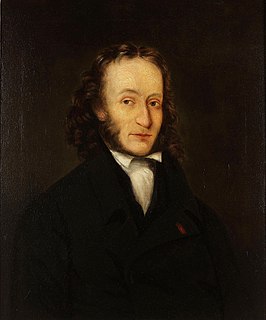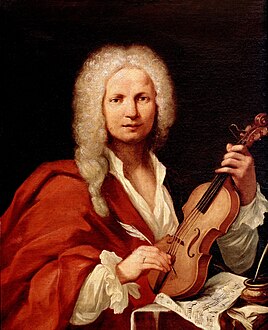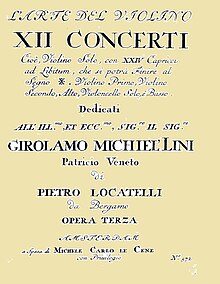
NiccolòPaganini was an Italian violinist and composer. He was the most celebrated violin virtuoso of his time, and left his mark as one of the pillars of modern violin technique. His 24 Caprices for Solo Violin Op. 1 are among the best known of his compositions and have served as an inspiration for many prominent composers.
The concerto grosso is a form of baroque music in which the musical material is passed between a small group of soloists and full orchestra. This is in contrast to the solo concerto which features a single solo instrument with the melody line, accompanied by the orchestra.

The Brandenburg Concertos by Johann Sebastian Bach (BWV 1046–1051, are a collection of six instrumental works presented by Bach to Christian Ludwig, Margrave of Brandenburg-Schwedt, in 1721. The original French title, Six Concerts à plusieurs instruments names six concertos for several instruments. Some of them feature several solo instruments in combination. They are widely regarded as some of the best orchestral compositions of the Baroque era.

Pietro Antonio Locatelli was an Italian Baroque composer and violinist.

L'estro armonico, Op. 3, is a set of 12 concertos for stringed instruments by Italian composer Antonio Vivaldi, first published in Amsterdam in 1711. Vivaldi's Twelve Trio Sonatas, Op. 1, and Twelve Violin Sonatas, Op. 2, only contained sonatas, thus L'estro armonico was his first collection of concertos appearing in print. It was also the first time he chose a foreign publisher, Estienne Roger, instead of an Italian. Each concerto was printed in eight parts: four violins, two violas, cello and continuo. The continuo part was printed as a figured bass for violone and harpsichord.
A capriccio or caprice, is a piece of music, usually fairly free in form and of a lively character. The typical capriccio is one that is fast, intense, and often virtuosic in nature.

La stravaganza, Op. 4, is a set of concertos written by Antonio Vivaldi in 1712–1713. The set was first published in 1716 in Amsterdam and was dedicated to Venetian nobleman Vettor Delfino, who had been a violin student of Vivaldi's. All of the concertos are scored for solo violin, strings, and basso continuo; however, some movements require extra soloists.

Diabolus in Musica, Accardo interpreta Paganini is a 1996 classical music album by violinist Salvatore Accardo playing musical works of Niccolò Paganini.
An organ concerto is a piece of music, an instrumental concerto for a pipe organ soloist with an orchestra. The form first evolved in the 18th century, when composers including Antonio Vivaldi, George Frideric Handel and Johann Sebastian Bach wrote organ concertos with small orchestras, and with solo parts which rarely call for the organ pedal board. During the Classical period the organ concerto became popular in many places, especially in Bavaria, Austria and Bohemia, reaching a position of being almost an integral part of the church music tradition of jubilus character. From the Romantic era fewer works are known. Finally, there are some 20th- and 21st-century examples, of which the concerto by Francis Poulenc has entered the basic repertoire, and is quite frequently played.

Johann Ernst of Saxe-Weimar was a German prince, son by his second marriage of Johann Ernst III, Duke of Saxe-Weimar. Despite his early death he is remembered as a collector and commissioner of music and as a composer, some of whose concertos were arranged for harpsichord or organ by Johann Sebastian Bach, who was court organist in Weimar at the time.

Guido Rimonda is an Italian violinist and conductor.

The Concerti Grossi, Op. 6, or Twelve Grand Concertos, HWV 319–330, are 12 concerti grossi by George Frideric Handel for a concertino trio of two violins and violoncello and a ripieno four-part string orchestra with harpsichord continuo. First published by subscription in London by John Walsh in 1739, in the second edition of 1741 they became Handel's Opus 6. Taking the older concerto da chiesa and concerto da camera of Arcangelo Corelli as models, rather than the later three-movement Venetian concerto of Antonio Vivaldi favoured by Johann Sebastian Bach, they were written to be played during performances of Handel's oratorios and odes. Despite the conventional model, Handel incorporated in the movements the full range of his compositional styles, including trio sonatas, operatic arias, French overtures, Italian sinfonias, airs, fugues, themes and variations and a variety of dances. The concertos were largely composed of new material: they are amongst the finest examples in the genre of baroque concerto grosso.
The Musette, or rather chaconne, in this Concerto, was always in favour with the composer himself, as well as the public; for I well remember that HANDEL frequently introduced it between the parts of his Oratorios, both before and after publication. Indeed no instrumental composition that I have ever heard during the long favour of this, seemed to me more grateful and pleasing, particularly, in subject.

Anyone for Mozart, Bach, Handel, Vivaldi? is a CD compilation re-issue of music by the Swingle Singers. It combines tracks from two previous LP releases, Going Baroque and Swinging Mozart.

Antonio Vivaldi wrote a set of concerti, Op. 11, in 1729.

Antonio Vivaldi wrote a set of concerti for violin, strings and continuo, Op. 12, in 1729.

Gaspard Fritz was a Swiss violinist and composer of the pre-classical period. He composed symphonies and chamber music.

Enrico Onofri is an Italian violinist and conductor specialising in Baroque music.













